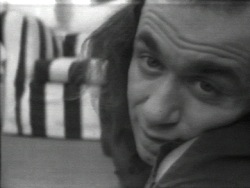Vito Acconci
Biography
The influential, provocative and often radical art-making practices of Vito Acconci have earned him international recognition. Acconci has been a vital presence in contemporary art since the late 1960s; his confrontational and ultimately political works have evolved from writing through conceptual art, bodyworks, performance, film, video, multimedia installation and architectural sculpture. Since the late 1980s he has focused on architecture and design projects.
In the 1970s, Acconci produced a body of conceptual, performance-based video works that retain an astonishing originality and force more than thirty years later. Seminal works such as Theme Song (1973) and The Red Tapes (1976) are among the major early works in the medium. Raw, crudely executed, and powerfully direct, Acconci's psychodramatic videos enforce an intensive dialogue between the artist and viewer, the body and the self, public and private, subject and object, absence and presence. Acconci used video as a vehicle for an intimate expression of self through the other, exploiting both the inherent immediacy and mediation of the technology.
In his video performances, the body is a site for a physical and psychological search for self, with language as the catalyst. Video is equated with the close-up, an intimate theatrical space for face-to-face confessionals and actions. Intensely personal, often to the point of exhibitionism, Acconci's stream-of-consciousness monologues and performative acts, documented in real time by a fixed camera, chronicle the insertion of the private self into the public sphere.
Early tapes, including Pryings (1971) and Remote Control (1971), are body-based exercises in which controlled performance situations are used to explore the dynamics of interaction through self-concentration or manipulation. Increasingly psychological and language-based in their expressions of self, works such as Undertone (1973) and Theme Song (1973) are charged, one-on-one confrontations with the other as "you." Implicating the viewer as witness, voyeur, or accomplice, Acconci assumes a manipulative stance in aggressive or seductive encounters with the spectator, whose presence is integral to the works. Video allows him to undertake a rigorous examination of the "I" through the process of forming an intensely intimate yet mediated relation between artist and other.
Defining his identity in the context of his art-making Home Movies, (1973), Turn-On, (1974), later works integrate autobiographical and narrative strategies in what he has termed an "introduction to myself." With his 1976 tour-de-force The Red Tapes, one of the major works in video, Acconci ultimately moves away from the interiority of a psychological, personal space, towards the construction of a self within a cultural, historical, and social space. Singular in its psychological engagement, its testing of performance, conceptual and body art processes, Acconci's articulation of self through video remains one of the most fascinating and complex investigations in the medium.
Prior to and during the period when he was making video works, Acconci also made a series of lesser-known Super-8 films. Dating from 1969 to 1974, these films further illustrate his distinctive engagement with conceptual art, performance and Body Art.
In contrast to the language-driven video works, the Super-8 films are silent. Focusing on gesture, ritualized action, and the body as a performance object, Acconci uses nonverbal means to investigate relationships, limits, mirroring, manipulations, and transformations. Performing a single action in front of a stationary camera, he presents the body as a site for a series of often provocative conceptual exercises: He methodically pulls out the hairs from around his navel, boxes with his own shadow, and plays with trans-gender illusions, for example. Unflinchingly direct and minimalist in execution, Acconci's Super-8 films reveal a rich field of conceptual investigation, and provide a compelling complement to his classic video performances.
Acconci's interest in the body and its relationship to space ultimately led to a focus on design. In 1988 he formed the Acconci Studio, a group of architects whose projects incorporate sculpture, furniture, public art and architecture.
Vito Acconci was born in the Bronx, New York in 1940. He received a B.A. from Holy Cross College and an M.F.A. from the University of Iowa. His work has been widely shown internationally, in solo exhibitions at the Sonnabend Gallery, New York; Museum of Contemporary Art, Chicago; Kölnischer Kunstverein, Cologne, Germany; Brooklyn Museum, New York; Whitney Museum of American Art, New York; and The Museum of Modern Art, New York, among many others. His work has been showcased at Rhona Hoffman Gallery, Pace/MacGill Gallery, Ricco/Maresca Gallery, Crown Point Press, Galleria Fumagalli, and Alessandro Berni Gallery. In 1987, a major retrospective of his work, entitled Vito Acconci: Domestic Trappings, originated at La Jolla Museum of Contemporary Art in California and traveled to sites throughout the United States. In 2016, a major retrospective of Acconci's work was organized by MoMA PS1 in celebration of their 40th anniversary, titled Vito Acconci: Where We Are Now (Who Are We Anyway?), 1976.
His work has also been shown in numerous group exhibitions, including the Venice Biennale; Palais des Beaux-Arts, Brussels; Documentas 5, 6, and 7, Kassel, Germany; several Whitney Museum of American Art Biennial Exhibitions, New York; Centre Georges Pompidou, Paris; Stedelijk Museum, Amsterdam, and the Kunstverein and Kunsthaus, Hamburg, Germany.
In addition to original fiction and poetry, Acconci has written critical pieces for catalogues and publications including New Observations, October, and Artforum. Among his numerous awards are grants from the American Academy in Rome; Berlin Deutscher Akademischer Austauschdienst; Guggenheim Foundation; New York State Council on the Arts, and the National Endowment for the Arts. He has taught at many institutions, including the Nova Scotia College of Art and Design, Halifax; California Institute of the Arts, Valencia; Cooper Union; School of the Art Institute of Chicago; Yale University, and Parsons School of Design.
Acconci Studio's architectural projects have included the United Bamboo Store, Tokyo, Japan; the Schacter Gallery, New York, and the artificial Mur Island, Graz, Austria, among others.
Acconci lived and worked in Brooklyn, New York, until his death in 2017.
